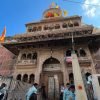The Jaipur Temple in Vrindavan is a majestic and significant religious site, drawing visitors with its rich history and architectural grandeur. Situated at the heart of Vrindavan and surrounded by a serene green environment, this sprawling temple was built by the esteemed emperor Sawai Madhao Singh. The temple is a testament to sterling Rajasthani architecture and artwork, making it a captivating sight for devotees and tourists alike.
Jaipur Temple – A Glimpse of History and Architecture

The Jaipur Temple, also known as Jaipur Mandir, holds a special place in the religious and cultural landscape of Vrindavan. Constructed by Maharaja Sawai Madho Singh Ji of Jaipur, this architectural marvel reflects the opulence and grandeur of Rajasthani craftsmanship. The temple’s intricate carvings, vibrant frescoes, and ornate designs are a testament to the rich cultural heritage of India.
Spiritual Significance
The temple is revered for its spiritual ambience and is dedicated to the worship of the divine. Visitors are drawn to the tranquil atmosphere and the opportunity to partake in the various darshan and aarti ceremonies, which offer a deeply immersive and reverent experience. The spiritual vibrancy of the temple, coupled with its serene surroundings, makes it a place of solace and devotion for pilgrims and tourists.
Development as a Tourist Destination
In recent times, there have been initiatives to develop the Jaipur Temple as a prominent tourist destination. The announcement of its development as a tourist attraction underscores its cultural and historical importance. This endeavour aims to showcase the temple’s splendour to a wider audience, inviting people to appreciate its architectural magnificence and immerse themselves in its spiritual aura.
Visitor Experience
For those who visit the Jaipur Temple, the experience is not just limited to the spiritual aspect. The lush greenery surrounding the temple adds to the overall charm, creating a serene and picturesque setting for visitors to explore and appreciate. The temple’s prominence as one of the largest and most popular in Vrindavan further enhances its allure, drawing in a steady stream of devotees and tourists year-round. In conclusion, the Jaipur Temple in Vrindavan stands as a testament to India’s rich cultural and religious heritage. Its architectural splendour, coupled with its spiritual significance, makes it a must-visit for those seeking a blend of history, art, and devotion. As efforts continue to elevate its status as a tourist destination, the Jaipur Temple is poised to captivate and inspire a global audience, inviting all to bask in its timeless grandeur and spiritual serenity.

































